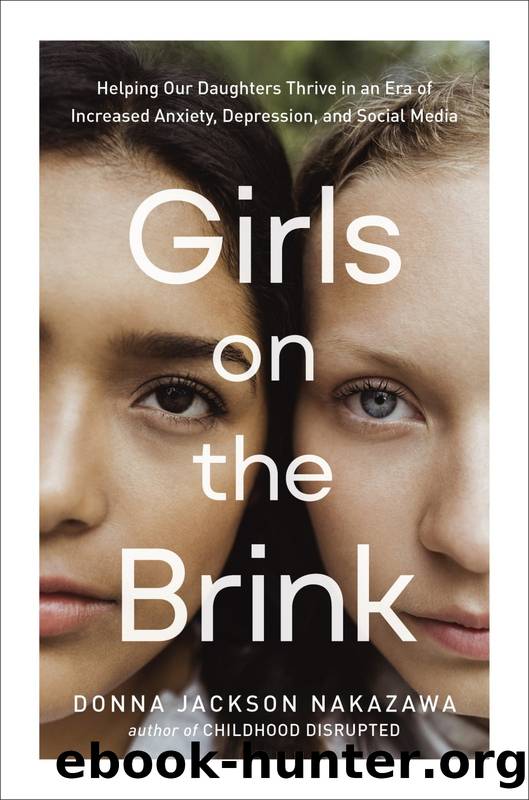Girls on the Brink by Donna Jackson Nakazawa

Author:Donna Jackson Nakazawa [Nakazawa, Donna Jackson]
Language: eng
Format: epub
Publisher: Harmony/Rodale
Published: 2022-09-13T00:00:00+00:00
Antidote 6
Donât Solve All Her Problems for HerâLeave Room for âa Little Wobbleâ
I want to be really clear here: Establishing psychological safety and family connection shouldnât be confused with overprotecting children and teens. Tracy Bale, Ph.D., neuroscientist at the University of Maryland, puts it this way: âWobble is good, but falling down is not.â Understanding this difference between wobbling and falling down is crucial to building resilience in girls. âThere are developmental windows during which children have to learn certain lessons about how to get through bumps in their friendships, or in meeting small challenges in their life, and see that they can manage a little kid-size failure, not fall apart, grow from it, and move on,â Bale says. In response to child-size adversities, the brain develops certain structures âor matrixes, that are a really important part of the architecture of the brain,â she explains. âThis wiring is really complex and intricate. It results from not only the good stuff you learn from healthy connection; itâs also formed from all of the bad stuff you learn from your screw-ups.â Bale draws upon her earlier analogy for adolescent brain remodeling, likening it to a house under renovation. The creation of these healthy and necessary brain matrixes is like âputting very strong, resilient plumbing in your house during a renovation, before you put up the walls. If you donât allow this to happen as children are growing up, itâs going to be a lot, lot harder to go back later at age twenty or twenty-five and try to help the brain build this neural structure.â
At the Yale Universityâs Child Study Center, known as SPACE (for Supportive Parenting for Anxious Childhood Emotions), researchers are examining the way American adults approach parenting to glean insight into what goes wrong when this wiring up of healthy, protective matrixes fails to occur. One of SPACEâs streams of research centers on reexamining what researchers call âaccommodating behaviors,â in which a parent tries to reduce a childâs anxiety by accommodating them in small but constant ways. Studies show that nearly 95 percent of parents of anxious children engage in such accommodating behaviors, and higher degrees of accommodation are linked to more severe anxiety symptoms. For example, repeatedly retying your childâs shoes for her because she complains they are too tight or uncomfortable; coaching your daughter through the rest of her history assignment after she dissolves into anxious tears; driving her to school because the bus is too noisy for her; double-checking her homework every morning as you pack her backpack for her; and so on. As a mother who raised an anxious daughter, I know of what I speak: When she was a toddler, I would find myself searching the house in a panic looking for her âbunny,â a five-inch-high stuffed rabbit Iâd given to her one Easter and without which she would not leave the house.
This kind of overaccommodating behavior is more likely to happen when parents are busy and tired and overwhelmed. Itâs easier to retie
Download
This site does not store any files on its server. We only index and link to content provided by other sites. Please contact the content providers to delete copyright contents if any and email us, we'll remove relevant links or contents immediately.
Rewire Your Anxious Brain by Catherine M. Pittman(18586)
Talking to Strangers by Malcolm Gladwell(13284)
The Art of Thinking Clearly by Rolf Dobelli(10312)
Mindhunter: Inside the FBI's Elite Serial Crime Unit by John E. Douglas & Mark Olshaker(9259)
Becoming Supernatural by Dr. Joe Dispenza(8159)
Change Your Questions, Change Your Life by Marilee Adams(7678)
Nudge - Improving Decisions about Health, Wealth, and Happiness by Thaler Sunstein(7655)
The Road Less Traveled by M. Scott Peck(7553)
The Lost Art of Listening by Michael P. Nichols(7452)
Mastermind: How to Think Like Sherlock Holmes by Maria Konnikova(7276)
Enlightenment Now: The Case for Reason, Science, Humanism, and Progress by Steven Pinker(7271)
Win Bigly by Scott Adams(7133)
The Way of Zen by Alan W. Watts(6547)
Daring Greatly by Brene Brown(6472)
Big Magic: Creative Living Beyond Fear by Elizabeth Gilbert(5675)
Grit by Angela Duckworth(5553)
Ego Is the Enemy by Ryan Holiday(5344)
Men In Love by Nancy Friday(5192)
The Laws of Human Nature by Robert Greene(5073)
